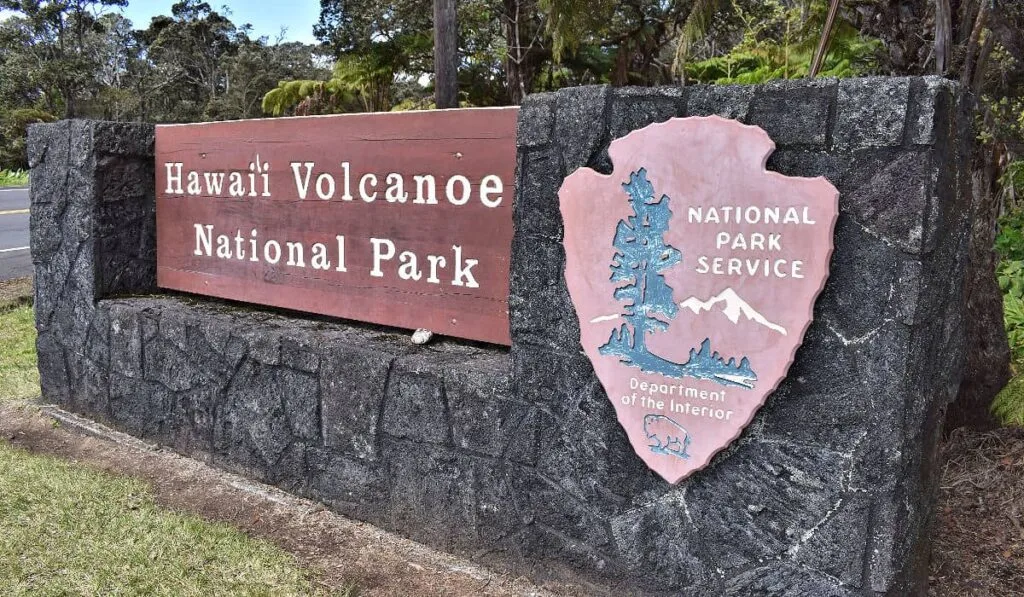
The Big Island of Hawaii (appropriately named Hawaii) is currently the largest of the archipelago Hawaiian Islands, and known for its active volcanoes. If you’re cruising to Hawaii, having a Hawaii Volcanoes National park itinerary will help to see as much as possible.
There are five volcanos on the Big Island; Mauna Kea, Kohala, Hualālai, Mauna Loa, and Kilauea. Hawaii Volcanoes National Park encompasses two of these; Mauna Loa and Kilauea, with the latter being the world’s most active.
The islands of Hawaii are popular for their paradise appeal. However, Hawaii brings travelers to see its stunning cascades like Akaka Falls, the star attraction Kilauea Volcano, and snorkeling in Kealakekua Bay.
A Living Laboratory
Whether a natural involving phenomenon or a sign of geological change, volcanic eruptions have fascinated people and scientists worldwide for centuries.
Looking back, I can vividly remember my emotions of standing inside a volcano (a dormant one in Tenerife in the Canary Isles, I might add) for the very first time. To this day, volcanoes still hold me captive with their immense power and unpredictable nature.
As one of the most active volcanoes globally, Kilauea Volcano is a great place for scientists to monitor volcanic activities. With a complex system of seismometers, GPS, and on-ground monitors, scientists can study the inner workings of a live volcano.
Planning your trip to Hawaii?
- Find your perfect accommodation on Booking.com
- Book your flight with WayAway
- Hire a car on Rentalcars.com
Geologists use the information gathered to predict eruptions in an attempt to lessen the impact on residential areas. Countries worldwide also come to Hawaii to develop better warning systems for volcanic eruptions, earthquakes, and tsunamis.
Getting There
If you’re staying on the island or arriving on a Hawaiian cruise, Hilo provides the closest access to the national park. While you can book a shore excursion, I prefer to rent a car from Hilo International Airport.
With a vehicle, I have the freedom to explore at my own pace and travel to areas of the park that the tours don’t usually go. I can also hike at some of my stopping points. Expect the drive from the airport to take around 40-45 minutes.
Hawaii Volcanoes National Park is accessible from both Hilo and Kona, although the day trip from the latter will take longer. You should check the current state of activity before you go.
The park is vast, so planning your itinerary aids in covering most of the highlights if you only have one day.
Hawaii Volcanoes National Park Visitor’s Center
The cost of entry is USD 30 per vehicle, and the pass is good for seven days. Alternatively, you can purchase a tri-park pass for $55. It allows access for one full year from the date of first use at Hawaii Volcanoes National Park, Haleakalā on Maui, and Pu‘uhonua o Hōnaunau National Historical Park.
I remember my first visit to see Kilauea during a port day on a Hawaiian cruise. I was surprised at the size of the park. At the park entrance, I received a park map showing the volcano and areas covered by previous lava flows.
The Kilauea Visitor Center was my first stop. Inside the park, it’s located to the right of the entrance. The volcano national park hours are 9 am to 5 pm daily.
At the center, the on-duty park rangers provided me with updated information, told me the best way to see the halemaumau crater and answered my questions on recent activities. They informed me of any closed areas of the park.
Across the road, Volcano House offers accommodations with guest rooms which overlook the crater for those wanting to extend their stay in the park.
Sulphur Banks Trail
From the visitor center, turn right and follow the Crater Rim Drive to Sulphur Banks and the steam vents. At Sulphur Banks (Ha’akulamanu), volcanic gases seep out of the ground along with underground steam. The smell from the steam vents is reminiscent of rotten eggs.
Volcanic gas comprises water vapor, although it can be rich in carbon dioxide, sulfur dioxide, hydrogen halides, and hydrogen sulfide.
In large concentrations, these gases are harmful to people, animals, and agriculture. For this reason, anyone with heart or respiratory conditions, pregnant women, infants, or young children should avoid this hike.
On the other side of the road, the Crater Rim Trail is a short and easy 1.2-mile (2 km) round trip, filled with steaming rocks and vibrant mineral deposits. The flat trail takes you to the lookout of Kilauea’s crater, and replaces the lookout where the Jaggar Museum once stood.
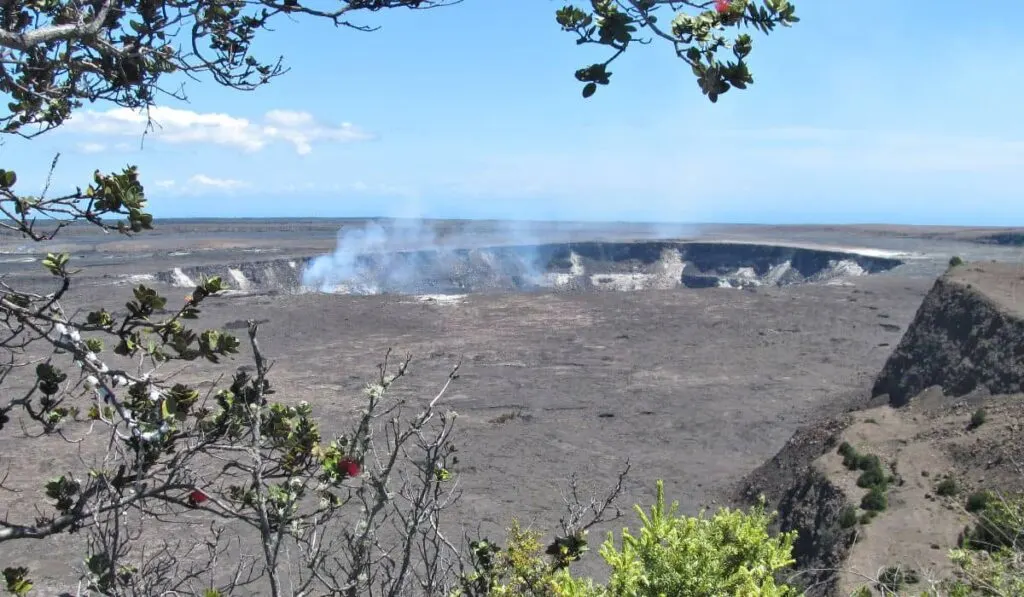
Since the eruptions in 2018, this is the closest you can get to the Halema’uma’u Crater. Be on the lookout for the pure sulphur crystals, as these are a real treat to see.
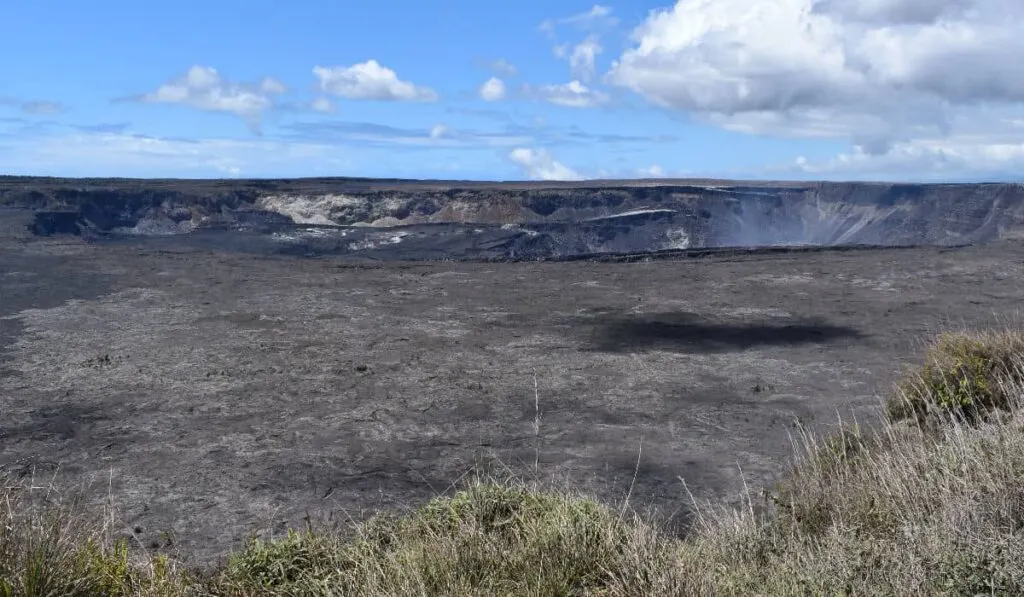
Having visited the volcano numerous times, I was surprised that the caldera has doubled in size. Kilauea now exudes a different facade.
The Chain of Craters Road
Head back to the visitor center and turn right onto the Chain of Craters Road. The road is open daily from 10 am to 9 pm, but check the Hawaii Volcanoes National Park website for closures.
The 19-mile roadway offers a scenic drive all the way out to the ocean. No water, food, or fuel is available along the Chain of Craters Road.
Should you book a shore excursion to Kilauea, your tour bus won’t include this road in your Big Island itinerary.
In 2003, lava flow covered part of the road just past the Hōlei Sea Arch. If visitors are permitted to the end of the way, the lava is available to view.
The drive is unique, offering views of Pauahi Crater and Mauna Ulu and dry lava beds from previous eruptions. If this is your first time to the park, this is a drive you must take.
I was fascinated by the ripples and soft layer designs in the lava fields. We stopped many times at lookouts and other regions to experience the magnitude of destruction caused by Kilauea.
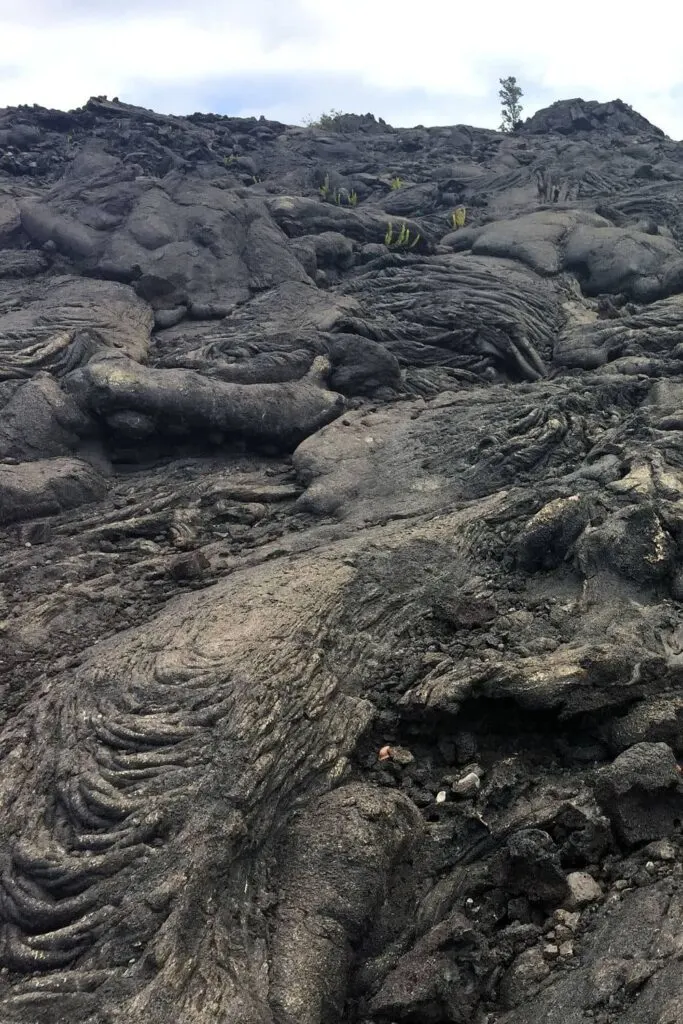
Depending on your time, consider a short hike across the dry volcanic landscapes at one of the stopping points. Each one offers a different perspective of vast lava fields, remnants of historic eruptions.
The Mauna Ulu trail, for instance, passes through a variety of volcanic features and offers views of dry lava beds. The Pauahi Crater trail is another option, showcasing the stark contrast of barren lava fields against lush vegetation.
There’s also a hike to see Petroglyphs. The Pu‘u Loa Petroglyphs, etched into centuries-old lava rocks, reflect the heritage and beliefs of Native Hawaiians, symbolizing wishes for longevity and prosperity. “Pu’u Loa” translates to ‘hill of long life.’
You’ll find the trail to these ancient artworks near the end of Chain of Craters Road, close to Holei Sea Arch. You can reach them via a brief 1.2-mile round trip hike, beginning at the Puʻu Loa parking area.
Hōlei Sea Arch
At the end of the road is a small parking area next to the Pacific Ocean. Take a short walk to the magnificent Hōlei Sea Arch. At 90 feet high, this natural arch is a prominent feature along the park’s coastline.
Standing about 90 feet tall, it formed from basalt lava, showcasing the dynamic geological processes of the Hawaiian islands. Although its exact age is uncertain, it is believed to have been formed relatively recently in geological terms.
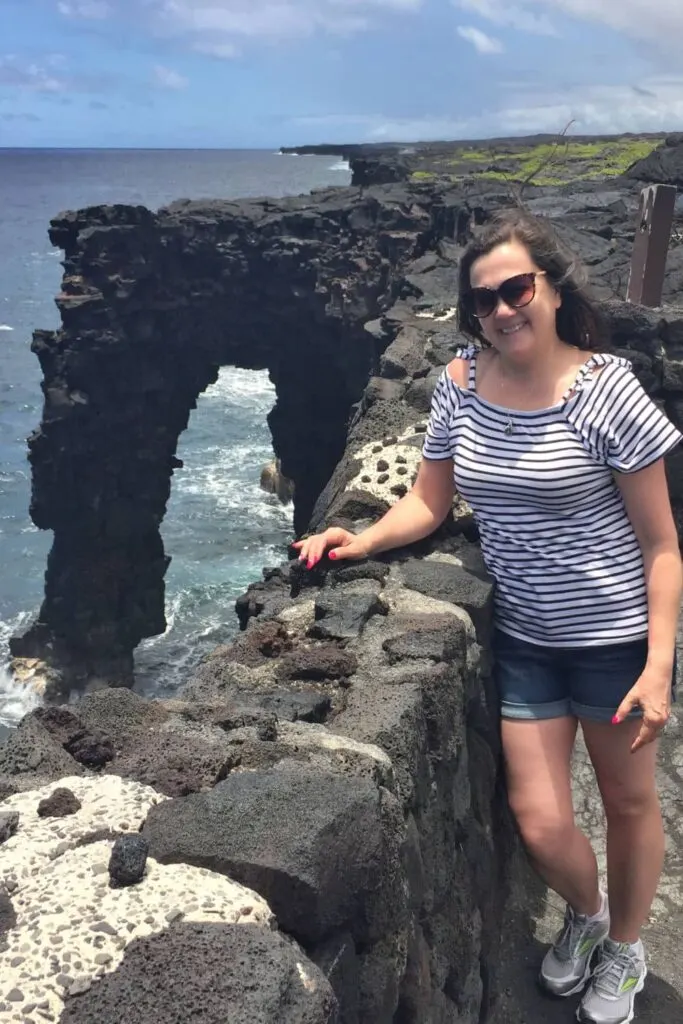
The arch is a popular spot for tourists, offering a unique glimpse into the natural beauty and geological history of Hawaii.
As the ocean waves crash against the lava tower, the arch will eventually crumble into the sea.
Devastation Trail
On the return drive, you have the option to stop at Devastation Trail. From the Hōlei Sea Arch to the trailhead, expect the drive to take 30 minutes, depending on traffic.
While Hawaii Volcanoes National Park has numerous trails, you’ll probably only have time to do one or two on a one day itinerary.
This trail offers a paved pathway featuring the fountain eruption of 1959. You’ll witness the slow return of life along this one mile out and back route.
Kilauea Iki Overlook
On route back to the visitor center, stop at the Kilauea Iki Lookout. Here, the views of Kilauea Iki are spectacular. Kilauea Iki is a fifty-year-old pit crater that is next to the main Kilauea crater.
From the lookout, it’s hard to grasp the magnitude of the crater. But look carefully, and you can see a faint trail across its surface.
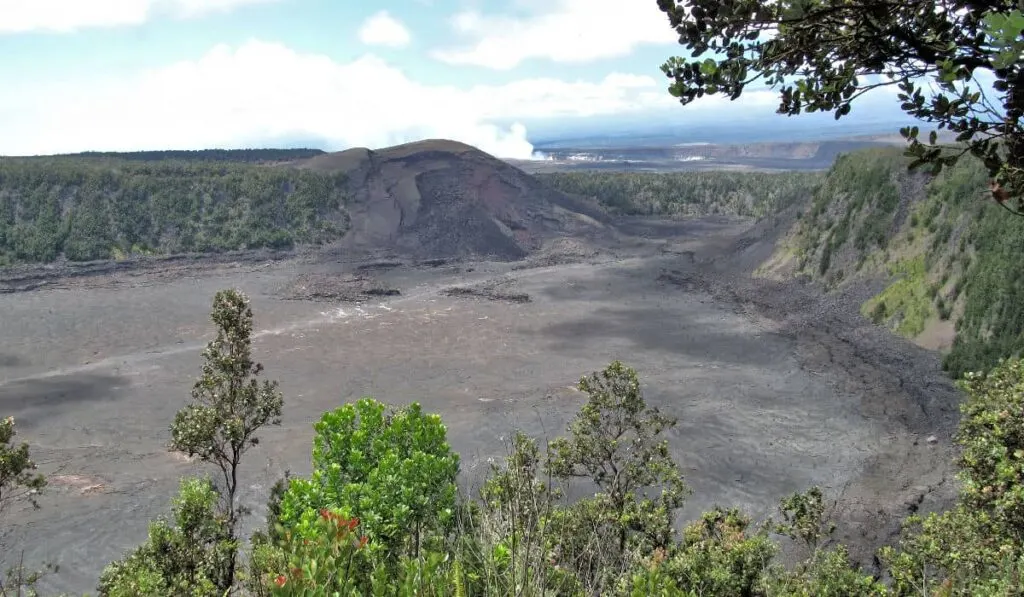
However, Kilauea Iki is vast, at one mile long, 3,000 feet across, and 400 feet below the parking area. A well-walked trail heads down into the crater and across the crater floor.
If you plan to take the trail to the crater floor, keep in mind, it’s dry, hot and the path offers little shade. Be prepared by wearing a sun hat, using sunscreen, and carrying plenty of water to stay hydrated.
Better yet, plan your hike in the earlier hours of the morning before the mid-day sun reaches its hottest temperatures.
Kilauea Iki Trail
For those adventurous enough to hike to the bottom, the four-mile looping trail takes approximately two to three hours. Even if you can’t make it to the end of the trail, reaching the black lava crater floor allows you to witness barren and lifeless landscape compared to the lush green jungle surrounding it.
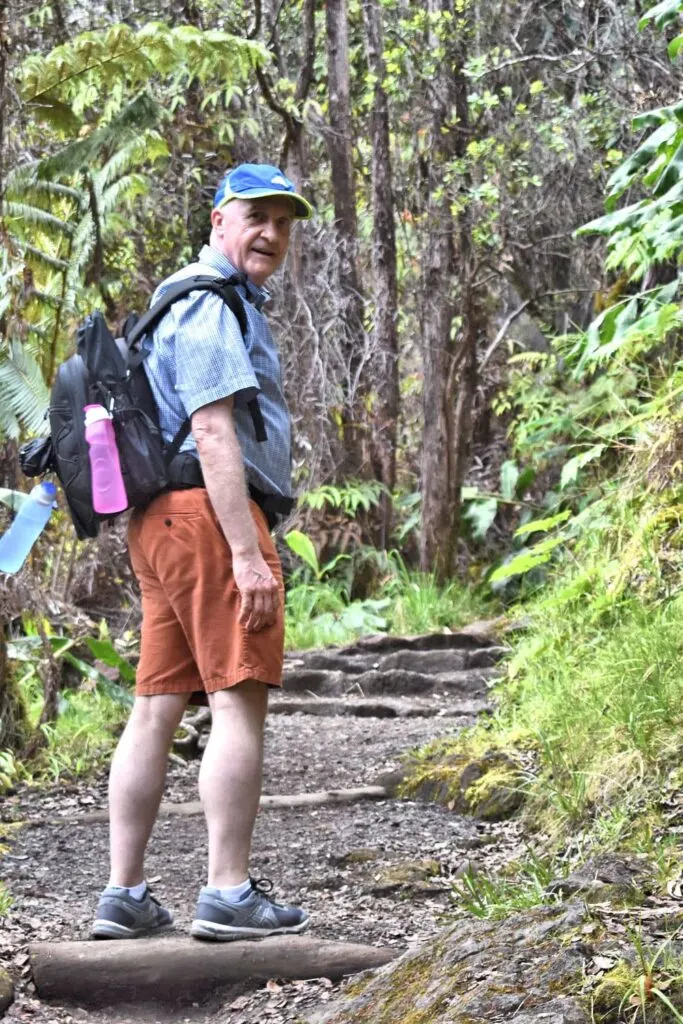
Be sure to look for the beautiful red flowers on the surrounding trees. The ʻōhiʻa lehua trees are the first signs of life on the lava since the volcano’s eruption.
While it was hot, we hiked the trail in the afternoon because it was the only way it could fit into our Hawaiian Volcanoes National Park itinerary. The start of the trail is flat and, at specific points, offers good views of Kilauea.
As the trail descends 400 feet to the crater floor, the tropical trees and plants provide some much-needed shade. It’s a stark comparison to the barren land found at the bottom of the trail.
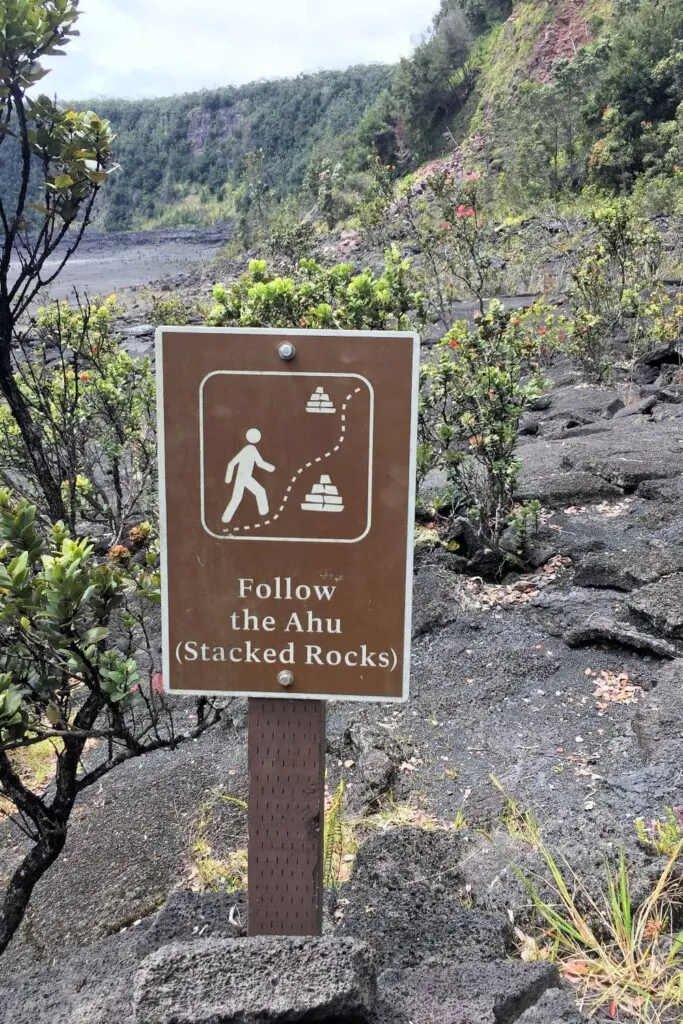
Walking out onto the crater floor is reminiscent of a desert. It’s barren, dry, and only a few scrubs have managed to grow amongst the dry lava floor. Black and hard, the lava bed is riddled with cracks, the result of shrinkage.
Seeing the large field of barren lava provides a harsh lesson in the destructive power of an explosive volcano. The trail continues across the crater floor and is marked by Ahu (stacked lava rocks).
It’s recommended to follow these rocks, and the path is well-worn like an animal track across the landscape. Pace yourself and keep some water for the trek back.
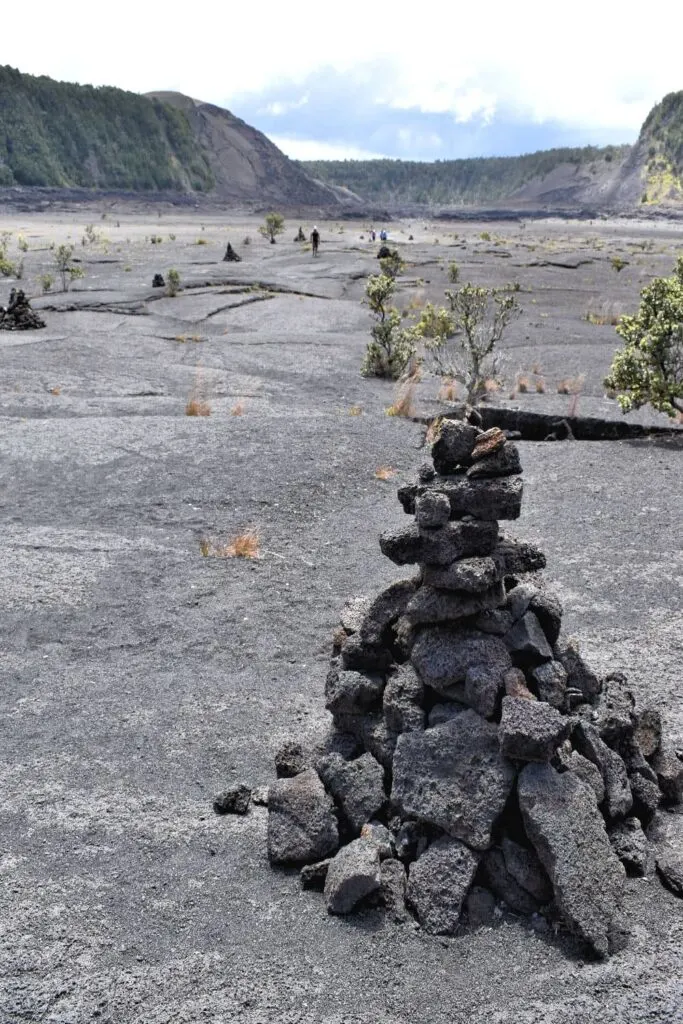
Remember, don’t be deceived by the easy trek down the Kilauea Iki Trail because it’s all uphill on the way back. If your time is limited, continue on Crater Rim Road for an overall experience of the park.
Thurston Lava Tube
The Thurston Lava Tube is one of the main attractions for visitors in Hawaii Volcanoes National Park. A lava tube marks the spot where an active lava flow ran and hardened.
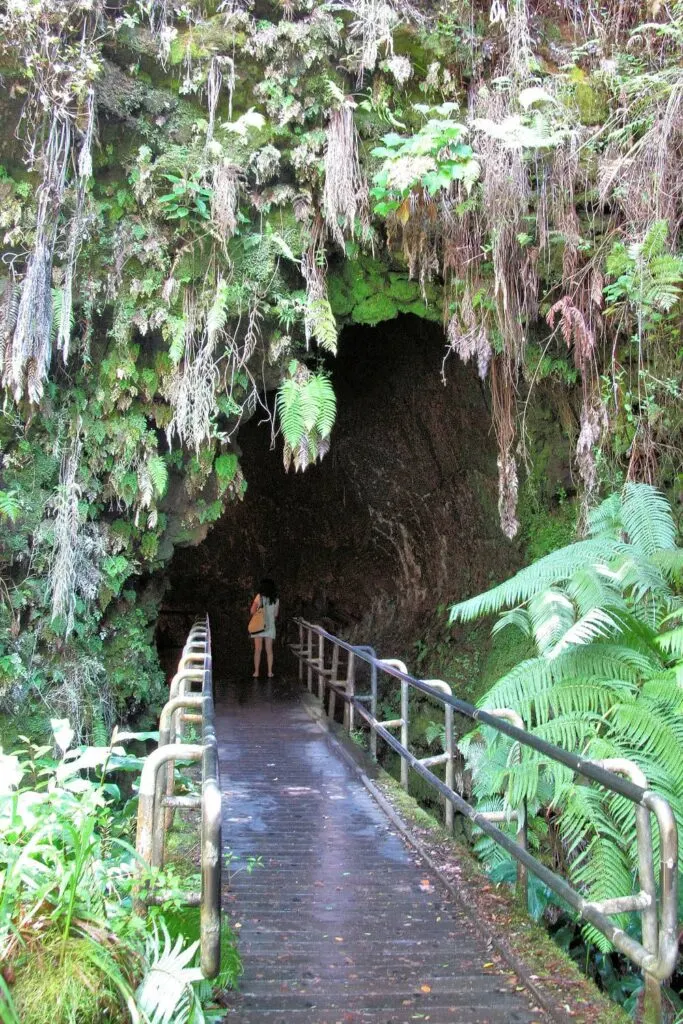
As the outside hardened, the inside continued to flow, leaving a hollow tube. Lava tubes are found on all the Hawaiian Islands but this one is tall and well preserved.
The Thurston Lava Tube or Nāhuku was created about 500 years ago. The 0.4-mile walk through the tunnel is easy, and can be done in 15 minutes.
In 2018, Kilauea eruptions and earthquakes damaged the Thurston Lava Tube, which caused it to collapse. Although through a recovery effort, this interesting natural wonder has reopened again.
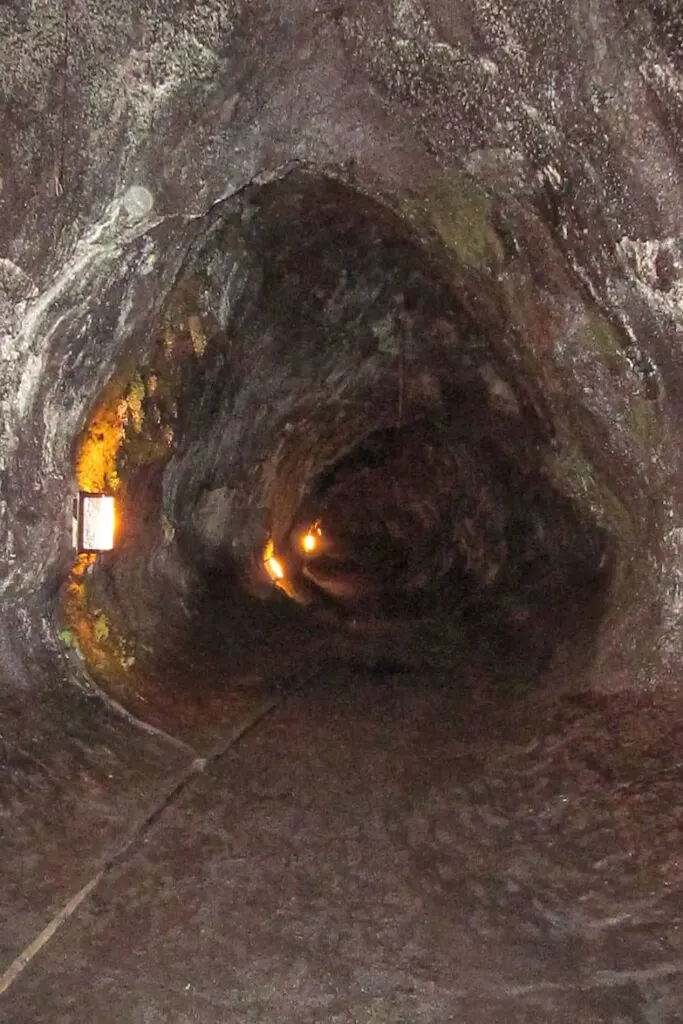
The Jaggar Museum and Halema’uma’u Crater Overlook
[Updated 2023] Due to volcanic activity in 2018, the Thomas A. Jaggar Museum is closed. The museum once gave visitors a quick run-down on the world of volcanoes, like an “everything you wanted to know.”
From there, visitors would have found the best views of the steaming Halema’uma’u Crater. Large amounts of the steam plume from this massive cater, known as the home of Pele, the volcano goddess.
There once was a large lava lake at the bottom of the crater. However, in May 2018, much of that lava has drained out through fissures into the Puna district.
Since this vital lookout point is no longer accessible by visitors, the best vantage point for viewing is on the Sulphur Banks Trail.
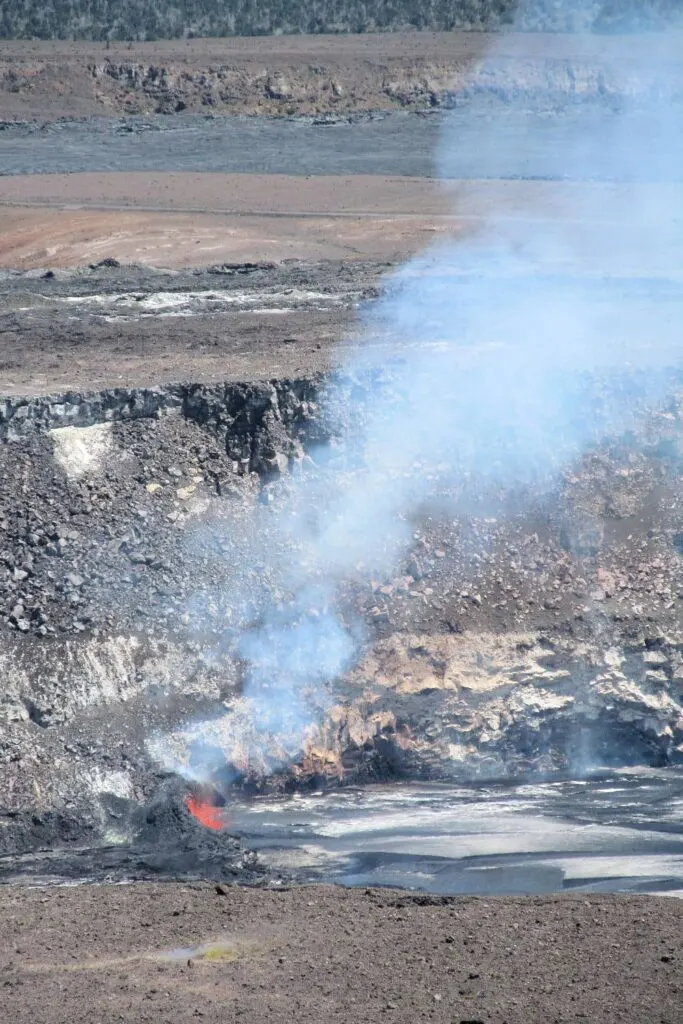
While I have visited Hawaii Volcanoes National Park several times, I was fortunate to see lava bubbling from the crater in May 2015. With a rental car, I ventured into the Puna district, where lava was flowing.
A visit to the Puna district was not complete without seeing Kalapana. Kalapana today is a dark ocean of solidified black lava, but once, it was a thriving fishing village.
Standing on the hardened lava, I realized the unpredictable fury of Mother Nature. There is a peacefulness about this barren land that is indescribable. There in the rocks, I found a sign that spoke volumes; “Serenity.”
How Much Can You See In One Day?
If you only have one day to explore the park, plan an early start. Drive to the end of Chain of Craters Road first to gauge your time. Expect to spend 3 hours to make the roundtrip drive, depending on your stops.
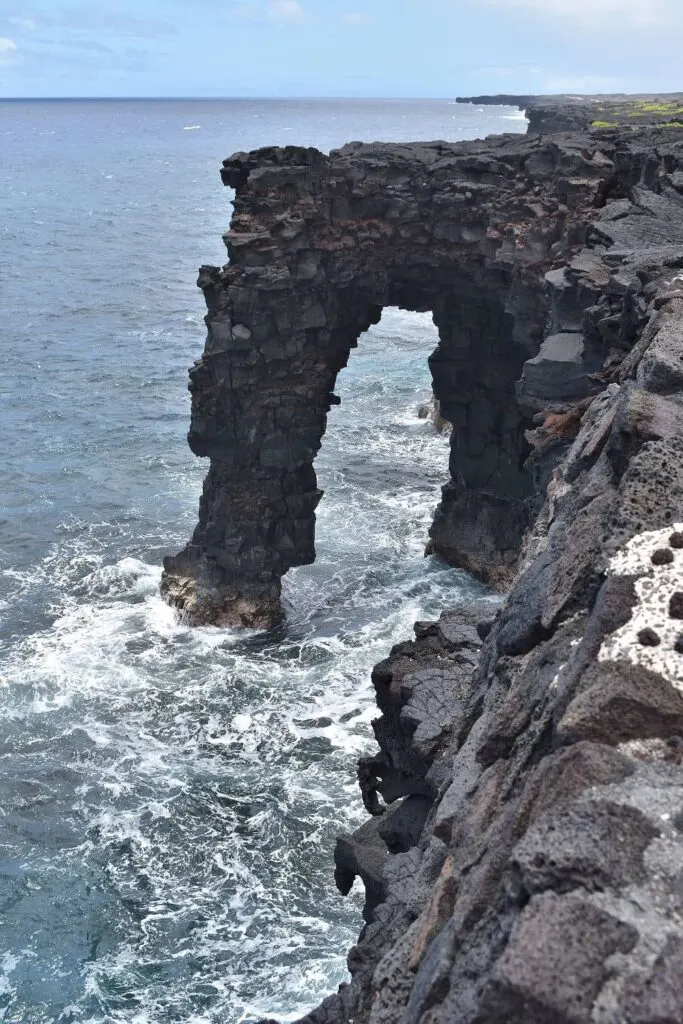
This is what you can realistically include:
- Chain of Craters Road
- Hōlei Sea Arch
- Thurston Lava Tube
- Kilauea Iki Overlook
- Sulphur Banks Trail
During our one day itinerary, we were able to do the Kilauea Iki Trail to the crater floor (not to the end of the trail). Alternatively, you could hike to the Pu‘u Loa Petroglyphs instead.
Final Thoughts
For me, visiting Hawaii Volcanoes National park was a humbling experience. There are no words to describe an area destroyed by a volcano, where there once stood a fishing village.
The National park is vast and although I’ve visited it on three separate occasions, there’s still lots more to discover. The landscape is forever changing with volcanic activity. The park I saw in 2012, 2015, and 2019 looks vastly different than the one seen today.
With endless walking trails and hikes across lava fields, an itinerary to Kilauea can last for as many days as you can manage. Should you decide to hike, wear closed-toe shoes as the lava is not so forgiving should you stub your toes.
Whether you have one day or a few days on the Big Island, Hawaii Volcanoes National Park is not to be missed. If you’re looking for something more adventurous to do, try swimming with the manta rays in Kona.
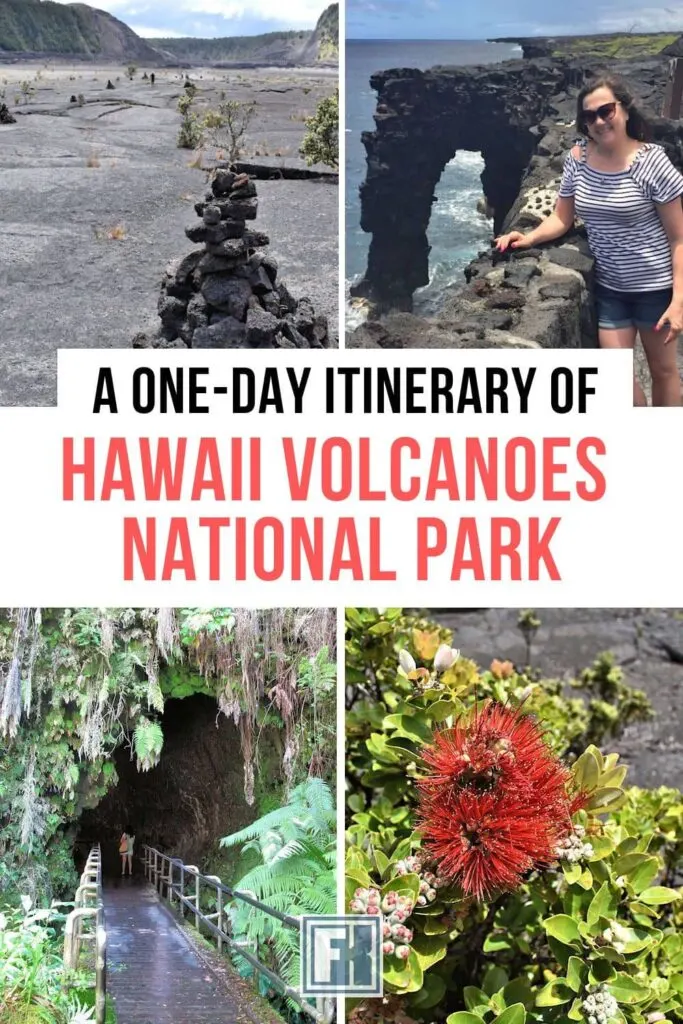


Dorothy StHilaire
Saturday 26th of March 2022
Thank you for your insight, I’m extremely excited for my visit to the big island of Hawaii in September of 22 . Volcanoe National park is definitely on my agenda.
Forever Karen
Saturday 26th of March 2022
Dorothy, I've been to Hawaii Volcanoes National Park several times and enjoyed every visit. The landscape changes a lot between visits because Kilauea is so active. I hope you have a wonderful trip.